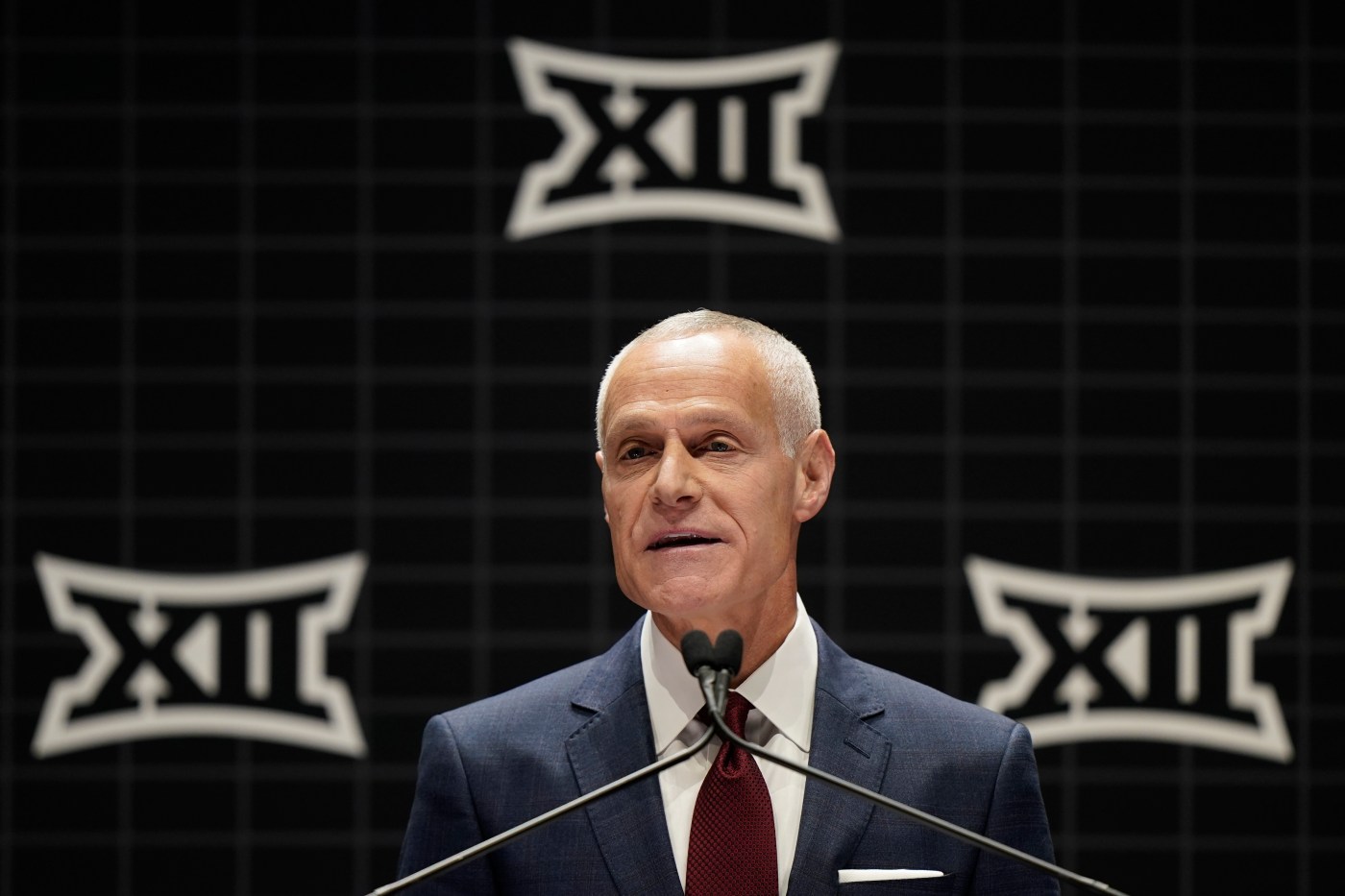
True to form, Big 12 commissioner Brett Yormark moved quickly and decisively with his latest nod to public perception. Minutes after the conference’s spring meetings concluded late last week, Yormark met the media and addressed the hottest topic in college sports: access to an expanded College Football Playoff starting in the 2026 season.
“We’re pushing 5 and 11,” Yormark said from Orlando without hesitation.
He was referring to the so-called 5+11 model that would grant five automatic bids to conference champions and leave 11 spots for at-large teams.
The other format under serious consideration for the 16-team event is commonly termed the 4-4-2-2-1 model, which assigns four automatic bids to the Big Ten and SEC, two to the ACC and Big 12 and one to the top-ranked team from the other FBS conferences. The final three spots would be reserved for at-large teams, with a special pathway for Notre Dame.
As commissioners discuss the merits of each model, the conferences in control of the CFP’s next chapter have staked out conflicting positions: The Big Ten favors 4-4-2-2-1 while the SEC leans 5+11.
Yormark prefers the latter.
In fact, Yormark proposed the 5+11 model, according to The Athletic, “as a way to appeal to the SEC’s ego.”
Yormark admitted it “might not be ideal” for the Big 12 but believes “it’s good for college football, and it’s what’s fair. We don’t want any gimmes. We want to earn it on the field.”
His strategy has drawn significant public skepticism, for there’s ample evidence to suggest that the 5+11 model would limit the Big 12’s access to the most important event in college sports.
That Yormark and his schools are making a momentous strategic mistake with lasting competitive consequences.
That the Big 12 should be elated with the two automatic bids that accompany the 4-4-2-2-1 model.
After all, the conference doesn’t come close to matching the relevant historical success of the Big Ten or SEC — or even the ACC.
Consider the number of appearances in the four-team CFP era (2014-23) for each power conference given post-realignment membership.
SEC: 17
Big Ten: 12
ACC: 7
Big 12: 2 (TCU and Cincinnati)
Or consider the number of Associated Press national championships this century based on current membership:
SEC: 15
Big Ten: 6
ACC: 4
Big 12: 0
Based on those data points, the Big 12 is clearly fourth among four. Any CFP model that would grant it equal footing with the ACC — and offer 50 percent access relative to the SEC and Big Ten — should be instantly and passionately supported.
And yet, Yormark is adamantly opposed to the 4-4-2-2-1 format.
Instead, he favors the 5+11 model that would only guarantee the Big 12 a single automatic bid. A second berth would depend entirely on the conference grabbing one of the 11 at-large slots that will assuredly be dominated by the Big Ten and SEC.
Put another way: The Big 12 has willingly selected the model that, on average, will offer higher risk, fewer bids and restricted access.
Even Fox analyst Joel Klatt, a former Colorado quarterback, believes Yormark’s strategy is misguided.
“I think (Yormark) is a really smart guy — he’s done a lot of excellent things with the Big 12,” Klatt said recently on his YouTube show. “He’s completely off the mark on this one …
“I think it is absolutely bananas that the Big 12 and their ADs (athletic directors) and their coaches would argue for this. Because they’re going to get crushed” by the 5+11 model.
That could very well be true. But for the Big 12, the choice of access models is not really about access. It’s about something greater than participation in the most important sport’s most significant event.
It’s about the Big 12 brand itself.
Under no circumstances — none, zero, zip — can Yormark support a CFP model that classifies his conference as inferior. That would, in a formal, binding document, acknowledge the Big 12 is something less than the Big Ten and SEC.
If on-field results and the at-large selection process in the 5+11 model place the Big 12 at a regular disadvantage, fine. The conference and its schools just continue to work toward greater success and better CFP representation. That’s the nature of competition.
Related Articles
College Football Playoff controversy: Time for Big Ten commissioner Petitti to explain his radical proposal
UConn leads our revised MBB Top 25 after NBA Draft deadline
College football: MW exit notice, CFP chaos, Big 12 cash, Leach’s HOF path
Why June is a vital month in the college football recruiting cycle
Mailbag: Assessing the CFP models and how they benefit the new Pac-12
But admitting to second-class status before the first kickoff of the first game of every season — well, that’s something far worse. That does immeasurable damage to your brand, your credibility and your very existence.
The 4-4-2-2-1 model would be the end of the Big 12 and ACC as we know them.
Ultimately, they might be forced to accept a system that codifies them as second-rate. If the SEC and Big Ten insist on 4-4-2-2-1, there’s nothing the ACC and Big 12 can do.
But they should make sure the college sports world knows they went down kicking and screaming.
That they fought for the model they believe is best for the game.
That the Big Ten and SEC are nothing more than bullies, forcing relegated status on the ACC and Big 12.
Predictably, Yormark is facing two bad options — there was never a chance the Big Ten and SEC would seriously consider CFP formats that did not tilt in their favor.
But one of the proposed models preserves self-respect for the Big 12 and ACC.
The other is a straight shot into the abyss.
*** Send suggestions, comments and tips (confidentiality guaranteed) to [email protected] or call 408-920-5716
*** Follow me on the social media platform X: @WilnerHotline